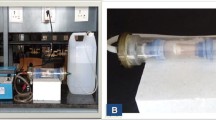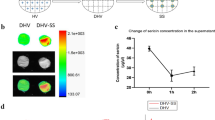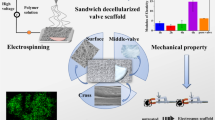Abstract
Decellularized heart valve scaffolds possess many desirable properties in valvular tissue engineering. However, their current applications were limited by short durability, easily structural dysfunction and immunological competence. Although crosslinking with chemical reagents, such as glutaraldehyde (GA), will enhance the mechanical properties, the low long-term stability and cytotoxicity of the scaffolds remains potential problem. Nordihydroguaiaretic acid (NDGA) is a bioactive natural product which is able to crosslink collagen and was proven to be effective in preparation of scaffold for tendon tissue engineering. In this paper, NDGA crosslinked decellularized heart valve scaffolds demonstrated higher tensile strength, enzymatic hydrolysis resistance and store stability than the non-crosslinked ones. Its mechanical properties and cytocompability were superior to that of GA-crosslinked heart valve matrix. Below the concentration of 10 μg/ml, NDGA has no visible cytotoxic effect on both endothelial cells (EC) and valvular interstitial cells (VIC) and its cytotoxicity is much less than that of GA. The LC50 (50% lethal concentration) of NDGA on ECs and VICs are 32.6 μg/ml and 47.5 μg/ml, respectively, while those of GA are almost 30 times higher than NDGA (P < 0.05). ECs can attach to and maintain normal morphology on the surface of NDGA-crosslinked valvular scaffolds but not GA-crosslinked ones. This study demonstrated that NDGA-crosslinking of decellularized valvular matrix is a promising approach for preparation of heart valve tissue engineering scaffolds.









Similar content being viewed by others
References
Brody S, Pandit A. Approaches to heart valve tissue engineering scaffold design. J Biomed Mater Res B. 2007;83B:16–43.
Schoen FJ, Levy RJ. Founder’s Award, 25th Annual Meeting of the Society for Biomaterials, perspectives. Providence, RI, April 28-May 2, 1999. Tissue heart valves: current challenges and future research perspectives. J Biomed Mater Res. 1999;47:439–65.
Hopkins PA. Tissue engineering of heart valves: decellularized valve scaffolds. Circulation. 2005;111:2712–4.
Kidane AG, Burriesci G, Cornejo P, Dooley A, Sarkar S, Bonhoeffer P, et al. Current developments and future prospects for heart valve replacement therapy. J Biomed Mater Res B. 2009;88B:290–303.
Kim SS, Lim SH, Cho SW, Gwak SJ, Hong YS, Chang BC, et al. Tissue engineering of heart valves by recellularization of glutaraldehyde-fixed porcine valves using bone marrow-derived cells. Exp Mol Med. 2006;38:273–83.
Lee CH, Jang YS, Her SJ, Moon YM, Baek SJ, Eling T. Nordihydroguaiaretic acid, an antioxidant, inhibits transforming growth factor-beta activity through the inhibition of Smad signaling pathway. Exp Cell Res. 2003;289:335–41.
Lambert JD, Dorr RT, Timmermann BN. Nordihydroguaiaretic acid: a review of its numerous and varied biological activities. Pharm Biol. 2004;42:149–58.
Goodman Y, Steiner MR, Steiner SM, Mattson MP. Nordihydroguaiaretic acid protects hippocampal neurons against amyloid beta-peptide toxicity, and attenuates free radical and calcium accumulation. Brain Res. 1994;654:171–6.
Arteaga S, Andrade-Cetto A, Cárdenas R. Larrea tridentata (Creosote bush), an abundant plant of Mexican and US-American deserts and its metabolite Nordihydroguaiaretic acid. J Ethnopharmacol. 2005;98:231–9.
Koob TJ, Willis TA, Hernandez DJ. Biocompatibility of NDGA-polymerized collagen fibers. I. Evaluation of cytotoxicity with tendon fibroblasts in vitro. J Biomed Mater Res. 2001;56:31–9.
Koob TJ, Hernandez DJ. Material properties of polymerized NDGA-collagen composite fibers: development of biologically based tendon constructs. Biomaterials. 2002;23:203–12.
Koob TJ, Willis TA, Qiu YS, Hernandez DJ. Biocompatibility of NDGA-polymerized collagen fibers. II. Attachment, proliferation, and migration of tendon fibroblasts in vitro. J Biomed Mater Res. 2001;56:40–8.
Koob TJ, Hernandez DJ. Mechanical and thermal properties of novel polymerized NDGA-gelatin hydrogels. Biomaterials. 2003;24:1285–92.
Pennisi E. Tending tender tendons. Science. 2002;295:1011.
Meyer SR, Chiu B, Churchill TA, Zhu L, Lakey JR, Ross DB. Comparison of aortic valve allograft decellularization techniques in the rat. J Biomed Mater Res A. 2006;79A:254–62.
Hyder PW, Fredrickson EL, Estell RE, Tellez M, Gibbens RP. Distribution and concentration of total phenolics, condensed tannins, and Nordihydroguaiaretic acid (NDGA) in creosotebush (Larrea tridentata). Biochem Syst Ecol. 2002;30:905–12.
Liang HC, Chang Y, Hsu CK, Lee MH, Sung HW. Effects of crosslinking degree of an acellular biological tissue on its tissue regeneration pattern. Biomaterials. 2004;25:3541–52.
Teebken OE, Bader A, Steinhoff G, Haverich A. Tissue engineering of vascular grafts: human cell seeding of decellularised porcine matrix. Eur J Vasc Endovasc. 2000;19:381–6.
Schenke-Layland K, Vasilevski O, Opitz F, König K, Riemann I, Halbhuber KJ, et al. Impact of decellularization of xenogeneic tissue on extracellular matrix integrity for tissue engineering of heart valves. J Struct Biol. 2003;143:201–8.
Zhai W, Chang J, Lin K, Wang J, Zhao Q, Sun X. Crosslinking of decellularized porcine heart valve matrix by procyanidins. Biomaterials. 2006;27:3684–90.
Han B, Jaurequi J, Tang BW, Nimni ME. Proanthocyanidin: a natural crosslinking reagent for stabilizing collagen matrices. J Biomed Mater Res A. 2003;65A:118–24.
Duisberg PC, Shires LB, Botkin CW. Determination of Nordihydroguaiaretic acid in leaf of Larrea divaricata (Creosote Bush). Anal Chem. 1949;21:1393–6.
Chang Y, Hsu CK, Wei HJ, Chen SC, Liang HC, Lai PH, et al. Cell-free xenogenic vascular grafts fixed with glutaraldehyde or genipin: in vitro and in vivo studies. J Biotechnol. 2005;120:207–19.
Flanagan TC, Wilkins B, Black A, Jockenhoevel S, Smith TJ, Pandit AS. A collagen-glycosaminoglycan co-culture model for heart valve tissue engineering applications. Biomaterials. 2006;27:2233–46.
Fischer D, Li Y, Ahlemeyer B, Krieglstein J, Kissel T. In vitro cytotoxicity testing of polycations: influence of polymer structure on cell viability and hemolysis. Biomaterials. 2003;24:1121–31.
Brody S, McMahon J, Yao L, O’Brien M, Dockery P, Pandit A. The effect of cholecyst-derived extracellular matrix on the phenotypic behaviour of valvular endothelial and valvular interstitial cells. Biomaterials. 2007;28:1461–9.
Migneco F, Hollister SJ, Birla RK. Tissue-engineered heart valve prostheses: ‘state of the heart’. Regen Med. 2008;3:399–410.
Badylak SF, Freytes DO, Gilbert TW. Extracellular matrix as a biological scaffold material: Structure and function. Acta Biomater. 2009;5:1–13.
Chaudhry B, Ashton H, Muhamed A, Yost M, Bull S, Frankel D. Nanoscale viscoelastic properties of an aligned collagen scaffold. J Mater Sci Mater Med. 2009;20:257–63.
Tudorache I, Cebotari S, Sturz G, Kirsch L, Hurschler C, Hilfiker A, et al. Tissue engineering of heart valves: biomechanical and morphological properties of decellularized heart valves. J Heart Valve Dis. 2007;16:567–74.
Silva RM, Silva GA, Coutinho OP, Mano JF, Reis RL. Preparation and characterisation in simulated body conditions of glutaraldehyde crosslinked chitosan membranes. J Mater Sci Mater Med. 2004;15:1105–12.
Sung HW, Chang Y, Liang IL, Chang WH, Chen YC. Fixation of biological tissues with a naturally occurring crosslinking agent: fixation rate and effects of pH, temperature, and initial fixative concentration. J Biomed Mater Res. 2000;52:77–87.
Author information
Authors and Affiliations
Corresponding authors
Additional information
Xiqin Lü and Wanyin Zhai contributed equally to this work.
Rights and permissions
About this article
Cite this article
Lü, X., Zhai, W., Zhou, Y. et al. Crosslinking effect of Nordihydroguaiaretic acid (NDGA) on decellularized heart valve scaffold for tissue engineering. J Mater Sci: Mater Med 21, 473–480 (2010). https://doi.org/10.1007/s10856-009-3924-9
Received:
Accepted:
Published:
Issue Date:
DOI: https://doi.org/10.1007/s10856-009-3924-9




